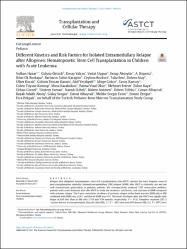Different kinetics and risk factors for isolated extramedullary relapse after allogeneic hematopoietic stem cell transplantation in children with acute leukemia

Göster/
Erişim
info:eu-repo/semantics/openAccessTarih
2021Yazar
Hazar, VolkanÖztürk, Gülyüz
Yalçın, Koray
Uygun, Vedat
Aksoylar, Serap
Küpesiz, Alphan
Ok Bozkaya, İkbal
Karagün, Barbaros Şahin
Bozkurt, Ceyhun
İleri, Talia
Atay, Didem
Koçak, Ülker
Tezcan Karasu, Gülsün
Yeşilipek, Akif
Gökçe, Müge
Kansoy, Savaş
Tüysüz Kintrup, Gülen
Karakükcü, Musa
Okur, Fatma Visal
Ertem, Mehmet
Kaya, Zühre
Gürsel, Orhan
Yaman, Yöntem
Özbek, Namık
Antmen, Bülent
Tüfekçi, Özlem
Albayrak, Canan
Adaklı Aksoy, Başak
Sezgin, Gülay
Albayrak, Davut
Sezgin Evim, Melike
Zengin, Emine
Pekpak, Esra
Üst veri
Tüm öğe kaydını gösterKünye
Hazar, V., Öztürk, G., Yalçın, K., Uygun, V., Aksoylar, S., Küpesiz, A. ... Pekpak, E. (2021). Different kinetics and risk factors for isolated extramedullary relapse after allogeneic hematopoietic stem cell transplantation in children with acute leukemia. Transplantation and Cellular Therapy, 27(10). https://dx.doi.org/10.1016/j.jtct.2021.06.023Özet
Relapse after allogeneic hematopoietic stem cell transplantation (allo-HSCT) remains the most frequent cause of post-transplantation mortality. Isolated extramedullary (EM) relapse (iEMR) after HSCT is relatively rare and not well characterized, particularly in pediatric patients. We retrospectively analyzed 1527 consecutive pediatric patients with acute leukemia after allo-HSCT to study the incidence, risk factors, and outcome of iEMR compared with systemic relapse. The 5 -year cumulative incidence of systemic relapse (either bone marrow [BM] only or BM combined with EMR) was 24.8%, and that of iEMR was 5.5%. The onset of relapse after allo-HSCT was significantly longer in EM sites than in BM sites (7.19 and 5.58 months, respectively; P =.013). Complete response (CR) 2 +/active disease at transplantation (hazard ratio [HR], 3.1; P <.001) and prior EM disease (HR, 2.3; P =.007) were independent risk factors for iEMR. Chronic graft-versus-host disease reduced the risk of systemic relapse (HR, 0.5; P=.043) but did not protect against iEMR. The prognosis of patients who developed iEMR remained poor but was slightly better than that of patients who developed systemic relapse (3 -year overall survival, 16.5% versus 15.3%; P =.089). Patients experiencing their first systemic relapse continued to have further systemic relapse, but only a minority progressed to iEMR, whereas those experiencing their iEMR at first relapse developed further systemic relapse and iEMR at approximately similar frequencies. A second iEMR was more common after a first iEMR than after a first systemic relapse (58.8% versus 13.0%; P =.001) and was associated with poor outcome. iEMR has a poor prognosis, particularly after a second relapse, and effective strategies are needed to improve outcomes.
Kaynak
Transplantation and Cellular TherapyCilt
27Sayı
10Koleksiyonlar
- Makale Koleksiyonu [3770]
- PubMed İndeksli Yayınlar Koleksiyonu [4223]
- Scopus İndeksli Yayınlar Koleksiyonu [6561]
- WoS İndeksli Yayınlar Koleksiyonu [6621]

















